The Haunting Memory of the Nuclear in Eiko Otake’s Spectral Performances
| September 2, 2021

Eiko Otake, A Body in Fukushima, 2014,Performance, Futaba District, Tomioka Town, Tomioka Fishing Harbor
Photo: William Johnston
All images courtesy the artist and the photographer
How does one represent the traumatic memories of a singular disaster in the context of the durational experience of nuclear catastrophes? A durational experience that is furthermore manifold. First, the nuclear disaster in 2011 resonates with the atomic bombings of 1945 and the loss of traumatic memories of those catastrophes. This loss of memories is a result of nuclear advocacy by the postwar Japanese government and the nuclear industry. It is also a major factor in tolerance for and negligence in the nuclear industry today in and beyond Japan. Second, the disaster is ongoing, as indicated in the recent announcement by the Japanese government that it would be releasing radioactive wastewater into the ocean within two years. Third, the disaster stretches into the further future, which is self-evident given our proximity to midnight on the Doomsday Clock and the longevity of radioactivity. In other words, nuclear catastrophe is not a singular occurrence, but a specter that has haunted humanity since the middle of last century. To address the durational catastrophe, then, how can artists represent the traumatic historical memories in a meaningful way that not only serves as an act of mourning but also as a call for critical reflection, and subsequently a claim upon the future? And within the context of this presentation, how can performance art, which is essentially an ephemeral occurrence, negotiate with the extensive temporality of nuclear catastrophe and the fragility of traumatic memories?
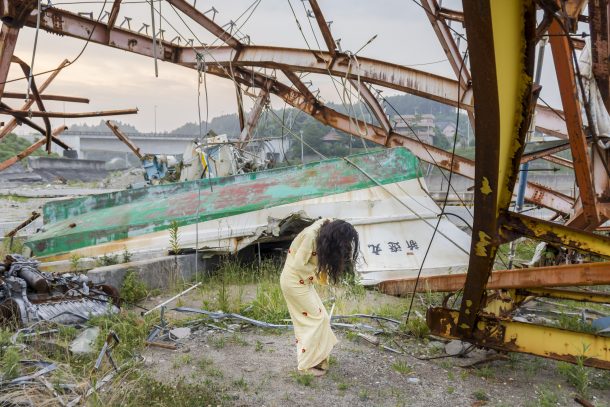
Eiko Otake, A Body in Fukushima, 2014,Performance, Tomioka
Photo: William Johnston
On March 11, 2011, a magnitude-9.0 earthquake, followed by a tsunami with waves up to 40 meters high, struck Japan. More than 18,000 people were killed or disappeared. In Fukushima the earthquake and tsunami triggered a meltdown in three nuclear reactors at the Fukushima Daiichi nuclear power plant. In August 2011, Eiko Otake, a Japanese artist who emigrated to the US in the 1970s, made her first visit to Fukushima. She was speechless, overwhelmed with sadness, remorse, and anger. As someone who had participated in the student movement in Japan during the late 1960s, Otake sees this nuclear disaster in connection with the atomic bombings of Hiroshima and Nagasaki in 1945 and the series of decisions made by the postwar Japanese government under the influence of the US. Moreover, having worked extensively during the 2000s with Kyoko Hayashi, a hibakusha (survivor of the atomic bombings), Otake also perceived the nuclear disaster from the perspective of Hayashi and mourned the loss of traumatic historical memories. In Otake’s “Dedication to Kyoko Hayashi,” delivered during a ceremony marking the sixth anniversary of the Fukushima disaster, and several weeks after Hayashi’s February 2017 death, she notes:
Hayashi lamented, “It is as if we, the atomic bomb survivors, did not exist. It is as if the experiences of the atomic bomb survivors have never counted for anything. While so many friends died because of the atomic bombings and suffered from radiation, Japan as a nation never learned anything about radiation.” I am heartbroken.
In January 2014 Otake made her second visit to Fukushima, with photographer and historian William Johnston. Her face and body covered in white powder, appearing as a pale, feeble figure in a kimono, she danced among the ruins. She often danced with a long piece of red silk fabric. She lay on the ground in despair, buried herself in bushes, and dipped her toes in the irradiated water, drawing the camera’s attention to a stopped clock, desolate domestic space, and a dusty child’s toy, symbols reminiscent of the catastrophes in 1945. At times she danced fiercely, while at others she seemed to be just wandering in the ghost town of Fukushima, roaming the abandoned train station. She looked like a specter who lingers in a place because of unresolved wishes, awaiting release. Otake has repeatedly visited Fukushima since 2014 and continues to do so now. The resulting photographs and videos have been titled A Body in Fukushima.
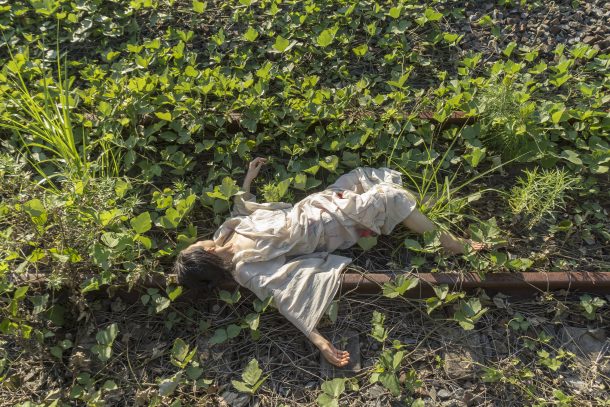
Eiko Otake, A Body in Fukushima, 2014,Performance, Momochi
Photo: William Johnston
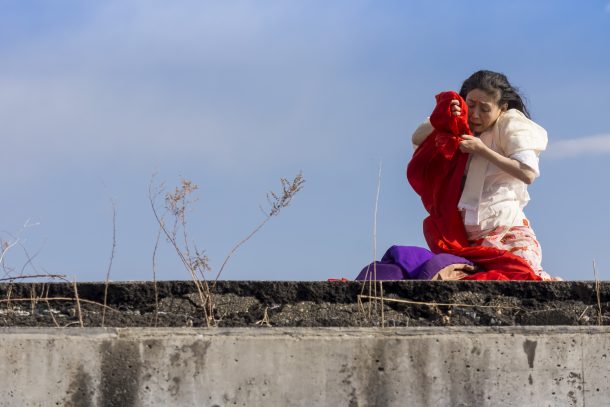
Eiko Otake, A Body in Fukushima, 2014,Performance, Sakamoto
Photo: William Johnston
A Body in Fukushima first appeared as a photo exhibition at Pennsylvania Academy of the Fine Arts to accompany Otake’s durational performance at Philadelphia’s 30th Street Station in October 2014. For Otake, this performance was a deliberate attempt to connect the Philadelphia train station with the abandoned train station in Fukushima. She sees her body as the constant in her performances, and thus as the site where different temporalities and spatialities meet.
From 2014 to 2019, Otake haunted more than 50 sites with her spectral performance, not only in the US but also Hong Kong, Chile and, more recently, Taiwan and Tokyo. The performances at these sites were usually accompanied by a photo exhibition or video installation of Otake’s dance in Fukushima.
With Otake dancing as the same spectral figure, time, space, and bodies become entangled and are woven into each other. Otake’s performance evokes a paradoxical awareness of the body in the audience—it invites a tenderness and care towards the body at the same time as it presents the othering of the body.
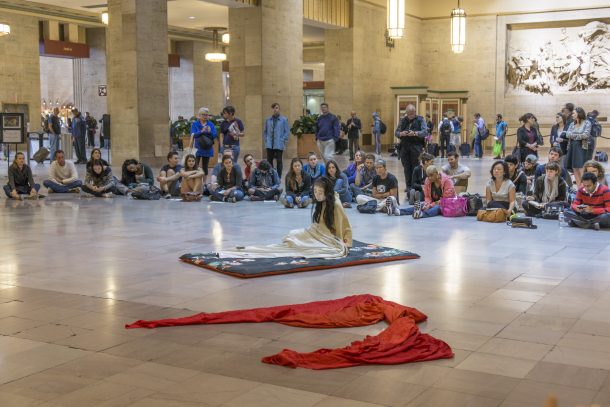
Eiko Otake, A Body in a Station, 2014,Performance, Philadelphia Train Station
Photo: William Johnston
The first performance of A Body in a Station unfolded among commuters moving according to their predetermined choreography through Philadelphia’s main railroad station. Otake, her face and arms covered in white makeup, and wearing a light-yellow kimono, appeared as the same spectral figure seen in A Body in Fukushima. She often moved with an extreme slowness, sometimes stretching her arms into the air or curling them in toward her body. At other moments she burst into a run for a few steps, waving the red fabric fervently. The audience usually formed a circle around her at a distance, and migrated with her as she moved to another spot, as though they were also guided by a certain choreography.
Otake’s performance draws intense attention to the body. The spectral, pale, helpless figure she presents invites care, often causing the passerby to consider whether she needs help. For instance, in the picture on the left, Otake pulls herself across the ground with extreme slowness and gestures as if she is trying to get ahold of something that nevertheless escapes her grasp, perhaps due to her weakness. As the poet and novelist Kirsten Kaschock has reflected in an article she wrote about the experience of watching Otake dance, the invitation to care reminds her of something essentially human: “Leaving the station, I felt opened again to my interconnectedness with others… I felt wakened, especially, to others in need: the aging, the weak, the grieving, the ill.”
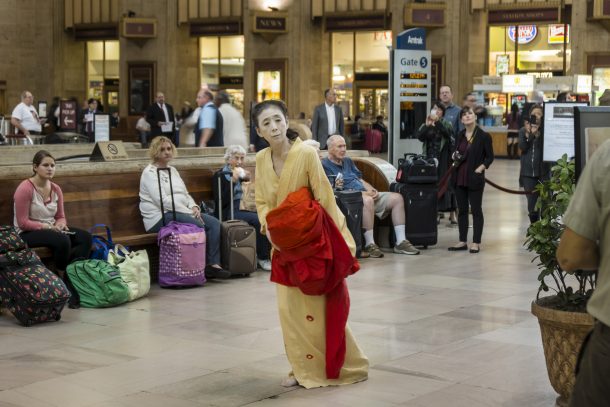
Eiko Otake, A Body in a Station, 2014,Performance, Philadelphia Train Station
Photo: William Johnston
Otake’s gestures often suggest carnal desire as well, such as hunger and thirst, both symbolically connected to nuclear catastrophes. In many of her performances, she thrusts chrysanthemum petals into her mouth, and then spits them out in a burst. Usually seen as a symbol of death and mourning in Japan, the chrysanthemum petals and the act of consuming them recalls the hibakusha’s experience of eating irradiated plants in the aftermath of the bombings of Hiroshima and Nagasaki. Sometimes Otake holds a bowl of water high over her upturned face, pouring it out into her mouth and spilling some onto the ground. The water, whether irradiated or not, evokes the anxiety caused by an invisible yet pervasive radioactivity. Her movements, often appearing uncanny or childlike, with their expression of carnal desire, autonomy, and vulnerability, seem to point toward the fundamental status of the body. A body that is moved by its desires and memories. A fragile body that may be injured, subjected to radiation, in need of help. A body that is a body, not marked by social class or nationality.
This invitation to care for the body is reinforced by the nontheatrical setting of Otake’s performance. In forming a natural alliance with the performer, each individual in the audience sees the other. The slowness in her dance not only engages with the temporal, but offers a space for the audience to ruminate. Occasionally attention slips from the center of the circle, from Otake, to the larger environment. Audience members begin to notice the others in this temporarily formed community, the busy travellers who retain a completely different speed and mode of movement, the ones who paused and decided to stay. Their attention drifts to the echoey hall in the train station, the modern technology and environment, and then bounces back to Otake, newly aware of how fragile, small, and ancient her body appears to be, and that surrounding her body is a communal space formed through collective effort. In connecting this performance with Otake’s performance in Fukushima, the audience is encouraged to reimagine the suffering experienced in a nuclear catastrophe through their own bodies and through a community understanding of the body.
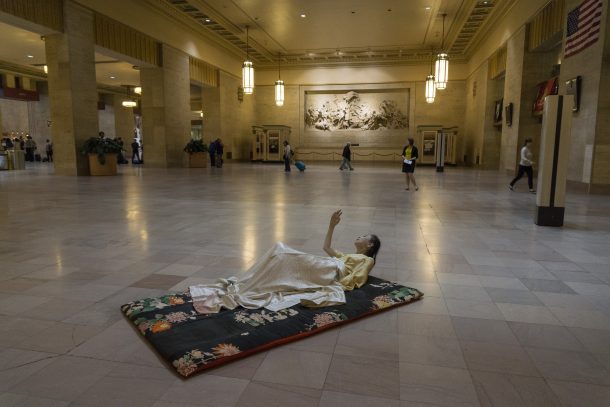
Eiko Otake, A Body in a Station, 2014,Performance, Philadelphia Train Station
Photo: William Johnston
However, this perception of the body is of course inevitably confronted with Otake’s gendered, aged, nationalized body at the same time, which is manifested most visibly in the kimono. This is a conscious choice for Otake. In interviews, she often refers to her figure as the “outsider.” She acknowledges that her immigrant/Japanese identity would be especially apparent in some settings, and she embraces the strangeness her figure presents to such audiences. The illness, distortion, weakness, and aging manifested in Otake’s body and in her movements also provokes fear or hesitation, through which Otake confronts the audience with their reluctance to see an unhealthy body in need. In addition, the confrontation of the strange bodies is further reinforced in the temporarily formed communal space. In recognizing this loosely knit community, the audience is made aware of their fellow audience members’ bodies, of Otake’s body, of their own body.
It is within this paradoxical awareness of the body that the audience is invited to understand and reimagine the history of nuclear catastrophe. The evocation of care and empathy encourages the audience to reimagine the traumatic history of Fukushima and atomic bombings through their own body—to imagine the pain, the fear, the radiation, the devastation. But at the same time, unavoidably they are confronted with their perception of Otake’s body as that of the stranger. Before gender, race, nationality, age, health, or corporeality, it is a body that is unfamiliar, alien. It is the Other.
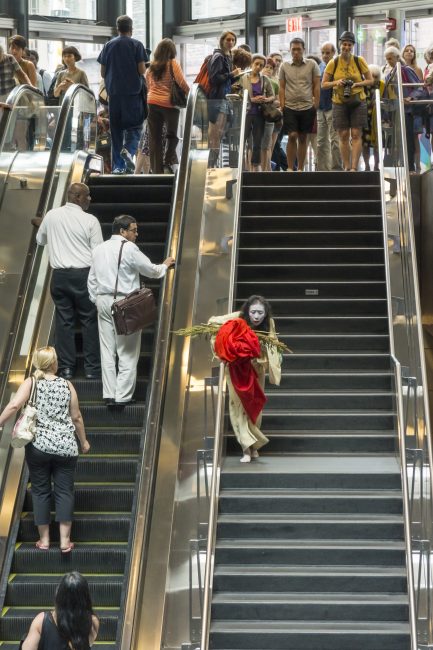
Eiko Otake, A Body in a Station, 2014,Performance, Fulton Station,New York City
Photo: William Johnston
Seeing a body as the Other is a historical condition. The body absorbs the history that accumulates within it, which is then manifested in the body’s affective reaction to events and to different groups of people. It asks the question: who do we see as the Other? Why do we see them as the Other? Why do we care for one group of people and turn a blind eye to another group? Placing these questions in the context of nuclear catastrophe raises further questions: does the need for electricity outweigh the needs of residents in “nuclear villages”? In the pursuit of abstract goals such as economic stability and technological development, what narrative was constructed around nuclear energy, and which group of people or what kind of bodies does the government stop caring for? Why were the traumatic memories of the hibakusha lost in today’s generation? Why are we afraid of seeing the unhealthy body? Keeping in mind the traumatic past, how do we reflect on the “bright future” that nuclear energy promised us?
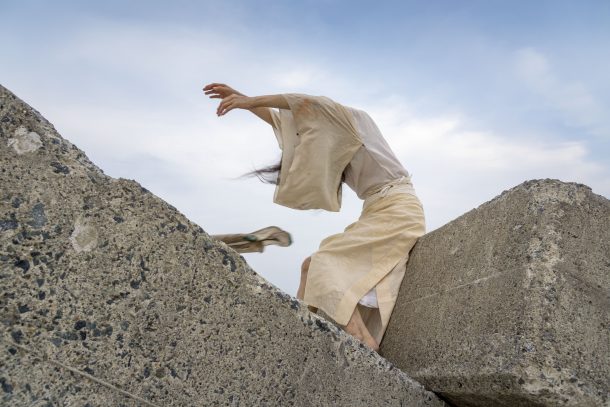
Eiko Otake, A Body in Fukushima, 2014, Performance, Tomioka
Photo: William Johnston
In Otake’s A Body in Places, the haunting of a traumatic past of nuclear catastrophe does not simply serve as a mourning ritual or a mnemonic reminder. By inviting the audience to reimagine the past through their own bodies, Otake not only fosters care for the victims of nuclear catastrophes but also encourages the audience to critically engage with the haunting history that resides within their bodies. Furthermore, in recognition of how the body is subject to power and narratives, the audience may also realize that the practice of care can be a subversive practice against such power. The body that is perceived both as the subject of care and as the Other is therefore the body that lingers between its past and its future. Raising such awareness in international audiences, Otake’s performance illuminates the fact that the nuclear accident in 2011 was not a catastrophe limited to a particular place and time; instead, it is a durational catastrophe connected in many ways with the international community. It poses the urgent question to the global audience: what should we do before the next nuclear catastrophe arrives?
Published on LEAP 2021 S/S Issue GHOSTED


